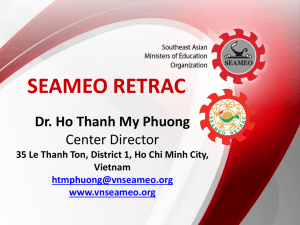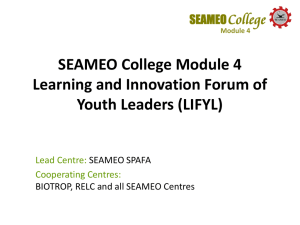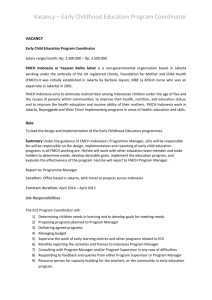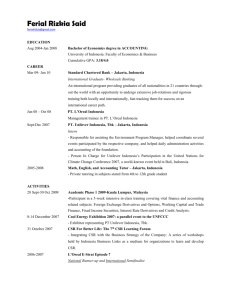ER- Bulletin Issue No.1 December 2007
advertisement
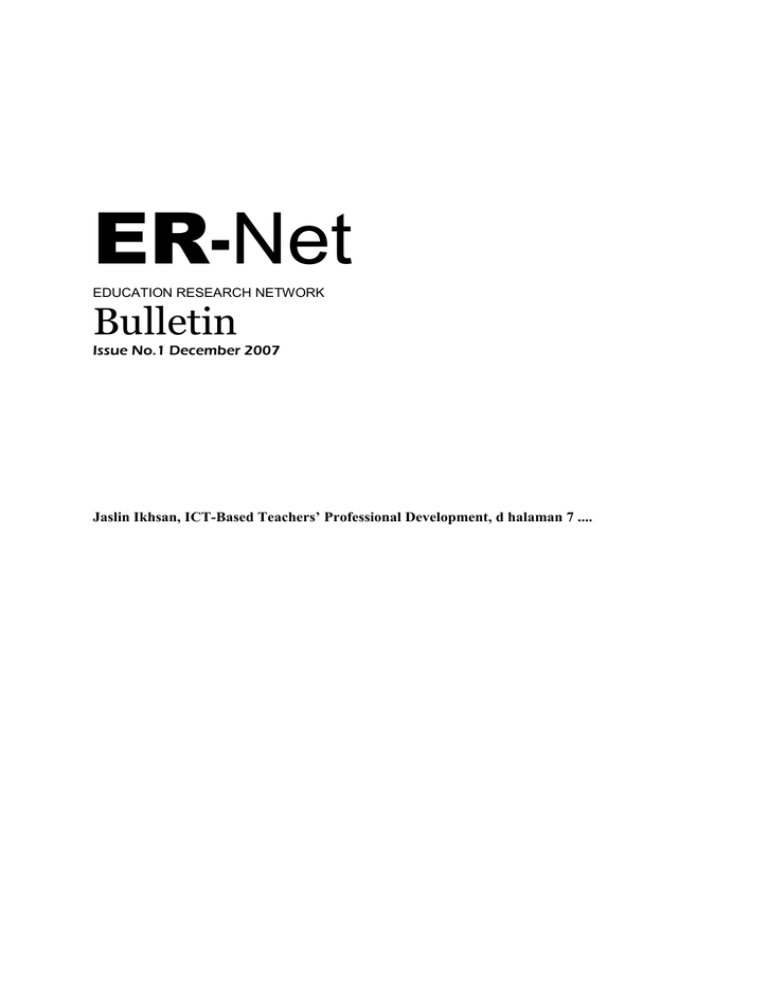
ER-Net EDUCATION RESEARCH NETWORK Bulletin Issue No.1 December 2007 Jaslin Ikhsan, ICT-Based Teachers’ Professional Development, d halaman 7 .... ER-Net Bulletin is published quarterly. All articles are free of copyright restrictions, and may be reproduced subject to an appropriate credit annotation ER-Net EDUCATION RESEARCH NETWORK Bulletin Issue No.1 December 2007 This bulletin is produced by: The Center for Policy Research and Educational Inovation, Agency for Education R & D, Ministry of National Education, Indonesia Ministry of National Education Building A, 2F Jl. Jenderal Sudirman, Senayan, Jakarta ph. 62.21.573.6365 facs. 62.21.574.1664 e-mail : puslitjaknov@yahoo.com www.er-net.or.id Editor-in-Chief : Agung Purwadi DEd. Editorial Assistant : Mahdiansyah Design/layout : Suparman Indonesia primary students - the winners at the 4th International Mathematics and Science Olympiad (IMSO) Jakarta, 11 - 17 Nov 2007 IN THIS ISSUE The Indonesia Initiatiatives on the Establishment of ER-Net for SEAMEO Member Countries Corporate Social Responsibility (CSR) on Education: How Network for More Effective Achievement THE INDONESIA INITIATIVESS ON THE ESTABLISHMENT OF EDUCATION RESEARCH NETWORK (ER-Net) FOR SEAMEO MEMBER COUNTRIES (1ST SENIOR OFFICIALS MEETING ON EDUCATION RESEARCH OF SEAMEO ) (Jakarta, Indonesia, 27 July 2007) Current Important Issues on Education in SEAMEO member countries Open, Distance, and e-Learning and Its Quality Assurance ISSN 1978-9165 9 771978 916570 Delegations of SEAMEO member countries at 1st SOM, Jakarta 27 July 2007 The First Senior Officials Meeting on Education Research (1st SOMER) of the SEAMEO Member Countries was attended by 16 Senior Officials of the 9 SEAMEO Member Countries and representatives from SEAMEO Secretariat. Timor Leste and Malaysia were absent. The delegates were warmly welcome by the Minister of National Education of the Republic of Indonesia, the 2 President of SEAMEO Council (represented by Dr. Baedhowi, Adviser to the Minister of National Education on the Curriculum Development and Educational Media). The Minister highlighted the background of the meeting and the three reasons why he supported the ER-Net Meeting. The three reasons comprise: 1.Indonesia through the R&D Agency has had long experiences in managing research network (Jarlit has spread all over Indonesia). This needs to be socialized to the neighboring countries. 2.The Act of the Republic of Indonesia Number 20/2003 on National Education System identified the key targets including the equity and expansion of access, the improvement of quality, relevance and competitiveness, and strengthening governance, accountability and public image on education. 3.The meeting is a follow-up of the SEAMEO Council Conference and ASEAN Education Ministers Meeting held in Bali on 13-16 March 2007. The meeting suggested the potential of new information and communication technology (ICT) for the renewal of education network in ASEAN member countries. The Meeting Proceeding Prof. Soekartawi, representing the host country, offered the concept paper to the delegates and invited them to comment for improvement. All delegates gave positive response and they basically agreed to have ER-Net among SEAMEO Member Countries. Initiatives from the delegates includes: (i) practising SMART activities (specific/unique, measurable, attainable, reasonable, and time bound), (ii) building website which contains education research activities of the member countries, and (iii) sharing information pertaining research and academic activities, such as seminars, symposium, training. OUTCOME AND RECOMMENDATION that networking is an effective way of communicating, exchanging, transferring, and delivering information. The meeting was resumed with some agreement on: The general objective for the establishment of ER-Net is to provide a mechanism for the sharing and re-using of SEAMEO and/or ASEAN education research results. The specific objectives are to: (1) design a closer relationship among education researchers in SEAMEO and /or ASEAN member countries, (particularly in the area of research knowledge management component), (2) develop a mechanism for the electronic, to capture, to storage, to share and to re-use lessons learned, best practices, models and methodologies generated by results of the education researches as an aid to policy-making, management and coordination, (3) strengthen educational resources available to each Member Country in the area at all level education (for example maximizing the use of ICT in developing and updating information among the member countries), and (4) strengthen activities that bring SEAMEO and/ or ASEAN students and teachers together, through more people-to-people in the member countries. 1.Concept Paper of SEAMEO ER-Net. The Concept Paper of SEAMEO Education Research Network or SEAMEO ER-Net shall be recognized to be the initiative of the Ministry of National Education of Indonesia. It was proposed and discussed by Senior Education Officers of SEAMEO member countries meeting in Jakarta on 27 July 2007. 2.SEAMEO ER-Net was developed based on an agreement of SEAMEO Council Conference and ASEAN Education Ministers Meeting in Bali 13-16 March 2007. The agreement was to suggest the potential of new information and communication technology (ICT) for the renewal of education network in ASEAN member countries. This can be done by extending, diversifying, and making knowledge and information available to a wider public. 3.SEAMEO ER-Net is considered to be practical way to solve the problem of unequal access towards knowledge and information available for them. Prof. Dr. Soekartawi explained the concept paper of ER-Net during the 1st SOM The establishment of ER-Net is important for the media of sharing, solidarity and equity among partners. Many scholars believed Approach The approach consideres (1) System dynamic or organizational culture, (2) Knowledge process and capture, and (3) Information and Communication Technologies (ICTs). The implementation of the program includes: •The Institutional Networking Component; •The Network Design and Architecture Component; •Institutional Strengthening and Capacity Building Component; •Knowledge Network Development Component; and •Policy Advocacy Component. The first four components will culminate with a Consultative Meeting. 3 Each component will have its own specific deliverables and may be considered as stand-alone sub-projects for funding purposes. To meet the expected output (the success network), there were seven critical factors that should be anticipated, namely: (1) common interest and mutual goals supported by strong commitment of all members of the ER-Net. (2) sharing resources and expertise, (3) recognizing benefits gained from better partnership, (4) reciprocal relationships, (5) system approach to management, and (6) unit or person assigned to operate daily activities. The Chairman of the meeting, represented by Agung Purwadi, D.Ed., Head of Center for Policy Research and Development and Educational Innovation, emphasized the importance of the meeting as it gave valuable insights on how to promote and enhance collaboration among SEAMEO member countries through networking. The First Monthly International Discussion on Education CORPORATE SOCIAL RESPONSIBILITY (CSR) ON EDUCATION: HOW TO NETWORK FOR MORE EFFECTIVE ACHIEVEMENT The First Monthly International Discussion on Education is aimed to get lesson learned form the business and private sectors with regard to mobilizing and utilizing education resources and innovative strategies for providing services through their Corporate Social Responsibility roles. The meeting was attended by representatives of 4 embassies of SEAMEO member countries: Cambodia, Myanmar, Phillipines, Timor Leste. Two international agencies (UNESCO Jakarta Office and AusAID Jakarta) were also present together with 5 company and foundation representatives from Yayasan Pendidikan PT Telkom, Coca Cola Foundation Indonesia, CITI PEKA, PT. Djarum, and Sampoerna Foundation. This important event was also attended by some senior officials of Ministry of National Education and staffs from Center for Policy Research and Educational Innovation, Office for Education Research and Development. Mr. Agung Purwadi, Head of Center for Policy Research and Educational Innovation, Office for Education Research and Development as Chair opened and outlined the background and objectives of the meeting to the forum. Agung Purwadi D.Ed said that this special meeting was to follow up the previous SOM of the SEAMEO member countries. The discussion was about the way companies could help provide education. CSR has been proven to successfully contribute to the improvement of education quality in the region. It provides education services to children and older people. In Search Of A More Effective Csr Framework (Priyanto Rudito, M.Bus., Telkom Education Foundation) (Jakarta, August 27, 2007) The foundations and companies who practising CSR:Sampoerna Foundation, Citi Peka, PT Djarum, and Prof. Dewa T. Komang (moderator) Presentation by Mr. Priyanto Rudito MBA of Telkom Education Foundation CSR has become a mandatory initiative, one of the most preserve initiatives. Current CSR Program and Policy: inherently part of CSR, internal scholarship for education and training program participants/students, financial donation directly provided to society, leverage of institution competence through specific designed training and development programs for communities and other institutions. Some of the CSR activities include donation, scholarships, and leverage of Institution Competencies. It is based on competence, capability, limited resource, link & match, cost, and benefit. Scholarships are provided for those who are disadvantaged by limited economic capability. The strategic framework for a more effective CSR is a gradual shift from a traditional to an “integrated” CSR. Traditional CSR aimed at building a good citizenship, whereas integrated CSR targeted at (i) building synergy in the regional ICT Management communities, (ii) building society ICTM knowledge development through strategic alliances, (iii) providing Indonesian society with more access to ICT cutting edge knowledge, (iv) providing scholarship and donation for educational excellence and to support those with financial limitation, and (v) donation for charity, culture and art appreciation activities in education sector. Modes of educational provision through CSR are provision of (i) industrial training (ii) ICT/software application training (for free), (iii) scholarship, and (iv) donation to society. CSR contribution accounts for 10.09 % of the total expenses of the foundation. 4 A Contribution to Indonesian Community (Triyono Projosoesilo, Coca-Cola Foundation Indonesia/ CCFI) Mr. Triyono Projosoesilo of Coca-Cola Foundation Indonesia (CCFI) explained the profile of CCFI The profile of CCFI consists of goals and strategies. The goals for developing program in the area of education are: (i) relevant to local needs, (ii) effectively empowering the community, and (iii) sustainable. The strategies of CCFI focus on long term programs, such as: (i) where the biggest difference can be made and (ii) the 3 CCFI Pronged Education program. The programs, on the other hand, refer to (i) facilities (such as learning center as core program), (ii) materials (book publications for learning center manual and biodiversity; and videos and (iii) skills (focused on local competencies of writing, training program, and workshop). (i) educating the next generation, (ii) enhancing educational opportunities for personal and professional development, and (iii) building communities and entrepreneurship, (iv) environment preservation, (v) financial education, and (vi) natural disaster relief and reconstruction. The strategies recommended include provision or implementation of: (i) financial grants for high school teachers to implement interactive learning activities with students, (ii) school based management of resources, (iii) Active, Joyful and Effective Learning (AJEL), (iv) community participation, (v) financial education benefit, (vi) comic book on basic money management, (vii) trainings, (viii) TV talk shows, (ix) one Volunteer Day or 8 working hours each year for each CITI staff. CSR on Education: How to Networking for More Effective Achievement (Rahman S.Hadi, PT. Djarum) Establishing a learning center is one of the long-term visions that is considered as a nucleus of all CCFI activities. This requires strong partnership with NGOs, Universities and Government. Mr. Rahman S. Hadi of PT. Djarum Citi Peka Education Program (Ditta Amahorseya, CITI PEKA) Mr. Lin Che Wei of Sampoerna Foundation and Ms. Ditta Amahorseya of CITI PEKA CITI PEKA is the umbrella for all Indonesia’s Citibank programs for the community. The programs comprise: PT. Djarum is responsible to nurturing Indonesian environment and its society. By using peaceful direct action and creative communication to expose global environment problems, and to force solutions for a green and peaceful future. PT Djarum will continue to harness the growth of the community surrounding. The goal of those is to ensure the ability of the earth to nurture life in all its diversity. PT Djarum provides programs as their responsibilities such as: (i) maintaining a strict monitoring of pollution and negative environmental impact by building wastewater treatment system, (ii) environmental protection by implementing reforestation, protect livelihood, (iii) scholarship for underprivileged university students. The students not only get a nominal but also some soft skills both national and regional activities such as factory visit, outbound, training, seminar, blood donor, and media visit, and (iv) athletic training from which several sports heroes and Olympic badminton medalist were born. CSR on Education: How to network for more Effective Achievement (Lin Che Wei, Sampoerna Foundation) For Sampoerna Foundation, CSR in Education aimed at : (i) building the company reputation through education, (ii) enhancing education of young people in the communities where the company operates, (iii) supporting schools in their efforts to add value to the development of young people by integrating business massages, (iv) increasing local understanding of the company’s operation, (v) providing opportunities for community involvement for the employees, (vi) developing (relevant) skills of potential workforce in the community, and (vii) building mutually beneficial relationships. The CSR programs consist of: (i) Schol arship, (ii) United School Program, (iii) Teacher Institute. Scholarship covers a range of options according to: (a) fields of study, (b) education levels, (c) location for study program (local and overseas). Scholarship may also an option for support components (i.e. full, partial, tuition only, etc.). United school program comprises options for: (a) schools close to production unit, (b) training in modular form and will be tailor made according to need assessment of each area, (c) in house training close to production area, (d) tailor made training program to suite local needs and (e) full scholarships 5 (scholars may be bound to work for the company upon graduation). Teacher institute is underlined by some conditions, such as: (i) the selection process will follow the Foundation’s rigorous process and strict guidelines, (ii) all selected scholars must follow the foundation’s mandatory programs and activities, such as development programs, social activities, annual gathering, internship program, etc Conclusion The Second Monthly International Discussion On Education CURRENT IMPORTANT ISSUES ON EDUCATION IN SEAMEO MEMBER COUNTRIES (Jakarta, September 27, 2007) Sessions are closed with the following conclusions and recommendations: •Budget provision of CSR is driven from programs-based on objectives, business strategies and company needs •CSR contribution on education should be started from basic level and to be customized according to needs •Private sectors are expected to pay more attention and give more contribution to the improvement of teacher quality in Indonesia •It is necessary to build a strong partnership or collaborative scheme between government and private sectors •Better coordination in conducting the program between government and non government (private sectors) is encouraged. The evidence of success in educational program should not only be seen from what the government has done but also from private sectors’ side •Information network is considered very important for the development of CSR. Participants from representatives of Thailand and Philippines embassies in Jakarta and international agency (AusAID Jakarta) ventional mode in the form of bulletin (R&D office plans to publish the first bulletin within a three-month time). Thirdly, information exchange through a modern mode (i.e. internet). The previous meeting came to a consensus to establish a solid, long-lasting, and useful website that provides members with the fastest way for information exchange. Systems, Issues and Challenges of Education in Indonesia (Poppy D. Puspitawati, Directorate for Development of Education and Training, MoNE) The 2nd Monthly International Discussion on Education, Jakarta, 27 Sept 2007, chaired by Dr. Agung Purwadi This second monthly international discussion was aimed at exchanging important educational information, sharing educational problems and solutions, and exchanging lessons in providing the most efficient ways to achieve the highest possible quality in education. It is expected that country members will reap the benefit of others’ experiences in dealing with similar problems. The meeting was attended by representatives of 5 embassies of SEAMEO member countries: Malaysia, Cambodia, Lao PDR, Philippines, and Thailand; representative of AusAID Jakarta, SEAMOLEC, and also by some senior officials of Ministry of National Education (MoNE) and staffs from Center for Policy Research and Educational Innovation, Office for Education Research and Development. Agung Purwadi D.Ed, as Chair, opened the meeting and welcome all the attendance on behalf of Research and Development (R&D) of Ministry of National Education, Indonesia. There are three modes of information as suggested at the previous meeting: Firstly, monthly discussion, which provides information exchange in a traditional face-to-face mode. Secondly, information exchange through a more con- Ms. Poppy D. Puspitawati, Directorate for Development of Education & Training, one of the presenter at the 2nd monthly discussion One of the challenges of education in Indonesia is the remaining high number of ‘drop outs’ in primary and junior secondary education. The declaration of 9-year compulsory education has not been successful. Illiteracy rate in age group 15+ is 10.81% and age group of 45+ is 28.57%. The number of cases varies according to: (i) age, (ii) gender, and (iii) location (i.e. city and remote area). Illiteracy for women in remote/rural area accounts up to 42.90%. In 1971 MONE recorded 50% of the people were illiterate, however, this figure declined to 10% in 2000, and it was projected to become 0% in 2007. Teacher act mentioned that all the teachers should at least hold S1 or D4 qualification, however, many teachers are still found to have D1 to D3 qualification. In the next 3 years, 222.343 teachers are to be retired and in 19 year time, more than 1 million teachers would retire. 6 The Roles of Equivalency Education (Usman Syihab, Directorate of Education Equivalency, MoNE) Equivalency Education has been defined as a part of non-formal educational program that includes: (i) package A which is equivalent to primary level; (ii) package B is equivalent to junior secondary level or SMP, and (iii) package C is equivalent to senior secondary education. Equivalency education focuses on mastery of knowledge, functional skill as well as attitude and personality development. The result of non-formal education can be valued as equivalent to formal education, after going through an equivalency assessment by a body delegated by central of local government as mandated in Law of National Education System No.20/2003 Article 26 clause (6) on Education National Standard. In registering to a higher education level, package A, package B or package C graduates hold the same eligibility and are equal to the holders of SD/MI, SMP/MTs, and SMA/MA certificates. Problems faced was that in the last 3 or 4 years, many people did not know what certificate was for package A or package B. To solve this problem, directorate made socialization on the importance of this program; the liability of acceptance; and the eligibility of the certificate. Mandate in the act education national system that the result of non-formal education can be valued as equivalence with formal education, certificate of package A, is equal to certificate of primary level. As a distinct, equivalency education aims to develop functional and professional personality skills so that: (i) package A graduates posses basic competencies to meet everyday needs; (ii) package B graduates may posses skills to respond to the demand of work place, and (iii) package C graduates may possess skills to be entrepreneurs. Managing Nine Year Compulsory Education (Didik Suhardi, Directorate for Development of Junior Secondary Education, MoNE) and non-formal Islamic JSS (Pondok Pesantren Salafiya); (vi) to provide school facilities to gain minimum service standard; (vii) to accelerate national movement for nine year compulsory education program. Researching Open and Distance Learning in Southeast Asia/ ODL (Dr. Paulina Pannen, SEAMOLEC) Mr. Didik Suhardi, Vice Director of Planning Division, Directorate for Development of JSE, MONE In1994, Indonesia declared a 9-year basic education or nine year universal basic education. The target is (i) how to achieve 95% of GER in junior high school in 2008/2009. An approximate of 100,000 13 to 15 year old are found not to enter junior high school. The implementation of a 9-year basic education has a big challenge after 3 years of its implementation. In 1997, Indonesia faced economic crisis and it significantly affected GER fluctuation (which was only 56.44%). Due to the economic crisis, the target of achieving 9 years basic education by 2003/2004 was extended to 2008 and 2009. At present, year 2007, GER has reached 93.79%. Some steps were undertaken to enhance GER: (i) to work on school mapping and data gathering from children aged 7-15 who did not enter basic education; (ii) to conduct socialization and publication to enhance the community awareness about nine year compulsory education; (iii) to give special attention to children aged 7-15 years, especially for: poor, street children, working children, children in remote areas; (iv) to provide scholarship and operational aid school program (BOS); (v) to develop school pattern to succeed nine year compulsory education based on the result of school mapping, namely (new school unit, new classroom, PS-JSS one roof, Open JSS, packet B, Islamic JSS, Dr. Paulina Pannen, Director of SEAMOLEC SEAMOLEC is the 15th SEAMEO center, which was established in 1997. The vision of the SEAMOLEC is to become the center of expertise in open and distance learning in Southeast Asia. The mission is to assist Southeast Asia countries in solving their educational problems through innovative, effective, efficient open and distance learning strategies. There are 4 core programs in open and distance learning (ODL) that are: (1) research and development, (2) training, (3) consulting, and (4) information dissemination. All of these are available under SEAMOLEC portal that is www. seamolec.org. There are some emerging issues in ODL profile in Southeast Asia such as (1) quality assurance, (2) accreditation, (3) instructional process (micro perspective) (a) media, (b) virtual or hybrid, (c) assessment, (d) students characteristics and culture. (4) economic issues, funding and sustainability and (5) government vs. private – social function. Hylite program is hybrid learning resources for Indonesian teachers. This is a support to government of Indonesia to upgrade the elementary school teachers from D2 to Sarjana 7 or Bachelor degree through open and distance learning employing hibernate learning model. This model is implemented by a consortium of 23 teacher colleges in Indonesia supported by many parties such as Directorate Generale of higher education, DG Quality Improvement for Teachers and Education Personnel, Bureau of Planning and International Affairs, MONE district offices, SEAMOLEC and also other partners. Hylite Program consists of: (i) hybrid learning resources and (ii) hybrid interactions. It is called hylite learning because hybrid learning resources are used, which comprise: (a) printed materials (b) audio visual, (c) computer based and (d) web-based courses (e-learning). Key issues for the hylite program are: (a) effectiveness and efficiency, (b) ICT-based ODL, (c) managing change in adoption of ODL by conventional teacher colleges, (d) consortium, (e) funding and sustainability and (f) quality assurance. Conclusion The sessions are resumed with two conclusions: (i) Information Communication and Technology (ICT) is important resource to improve an access and the quality of education; and (ii) ODL can be considered as an alternative Education Provisional and Educational Management. The Third Monthly International Discussion On Education OPEN, DISTANCE, AND E-LEARNING AND ITS QUALITY ASSURANCE (Jakarta, 30 October 2007) The meeting was officially opened by Dr. Agung Purwadi, Head of the Center for Policy Research and Educational Innovation, Office for Education Research and Development and as Chairman of the organizing committee. After welcoming all guests, Dr Purwadi reviewed the results of the previous meetings which comprise: 1.Information exchange on education related matters through monthly discussion. 2.Education information exchange through bulletin. 3.Information exchange through website. The topic raises at this meeting was about Open, Distance, and e-Learning and its Quality Assurance, which are considered as a new way of providing more access to education at the same time providing a guaranteed quality of education. quality of Indonesian teachers. KP has been implementation in 20042006 as a forum in which teachers can improve themselves based on the reflection with the use of various strategies and innovation on teaching and learning. The KP teachers can discuss their problems and share experiences through a website address www.klinikpembelajaran.com under the supervision of lectures from teachers training institution. Some advantages of Klinik Pembejaran (KP) were pointed out: 1.KP is an ICT based learning to support life long learning for teachers without limitation of place and time as well as life wide. 2.KP can significantly help teachers to solve their teaching problems in class. 3.KP helps teachers to improve learning skills and to update themselves with new information and knowledge they need as a member of a society Assuring Quality In Open And Distance Learning System (Dina Mustafa, SEAMOLEC) ICT-Based Teachers’ Professional Development (Dr. Jaslin Ikhsan, SEAMOLEC) Dr. Agung Purwadi (Chairman) and Prof. Dr. Soekartawi (Moderator) Dr. Jaslin Ikhsan, SEAMOLEC as presenter and Prof. Dewa T. Komang as moderator The issue raised was the importance of Klinik Pembelajaran (KP: Indonesian Teaching Clinic) to develop the Ms. Dina Mustafa, Marketing, Research and Development Manager, SEAMOLEC Dina Mustafa discussed the quality assurance indicators in ODeL, includes principles, providers, program, resources, and recipient. A guideline is needed to respond to the need for enhanced understanding on the concept of ODeL, its roles and functions, and its quality assurance concerns, especially in higher education setting. It covers general elaboration on the development of open and distance 8 learning in higher education in Southeast Asia, quality assurance in open and distance learning, and indicators process, and practices of quality assurance in ODeL in Southeast Asia. In the presentation a manual is offered as a framework for government and funding agency and as a model for institution and public in general. The manual covers indicator process and implementation of Quality Assurance (QA) in Southeast Asia. Two important issues were raised: (1) How to measure quality in ODeL (Method of QA) , (2) Why it is important to assure quality of ODeL graduates (Reasons for QA). Method of QA consists of (i) internal driven (a) institutional research, (b) learning assessment, (c) staff development; (ii) external imposed (a) accreditation, (b) public accountability. Reasons for QA are of 5 folds: (i) Institution (to examine the achievement of mission and objectives), (ii) Prospective students (academic potential and qualification), (iii) Program (satisfaction, employers’ expectations), (iv) Evaluation (learning and assessment), (v) Research (roles of key participants, technology selection and adoption, design issues, strategies to increase interactivity and active learning) Conclusion Open distance and e-Learning is a preferred avenue for developing teachers’ professionalism. Teachers’ qualification is no longer a discourse as this is considered as a serious matter that significantly contributes to teacher certification. Teachers’ professional development comprises two aspects: first, academic qualification (academic degree), and second four dimension of competencies: pedagogical, social, personality, and professional. Indonesia students - the winners - at the 39th International Chemistry Olympiad (ICh), Rusia 12-14 July 2007 The winners - gold medal - from indonesia student at the 38th International Physics Olympiad (IPhO) in Isfahan, Iran, 13-22 July 2007 Participants, and speakers of the 4th Monthly International Discussion on Education: Education Portal for Alternative Educational Provision and Education Management, held in MONE Indonesia, Jakarta 26 November 2007
